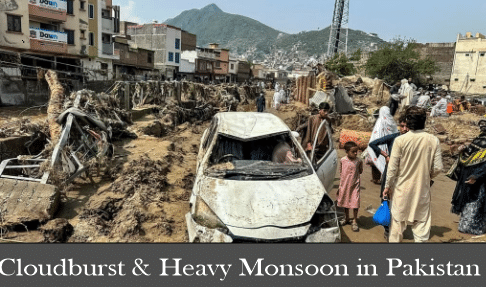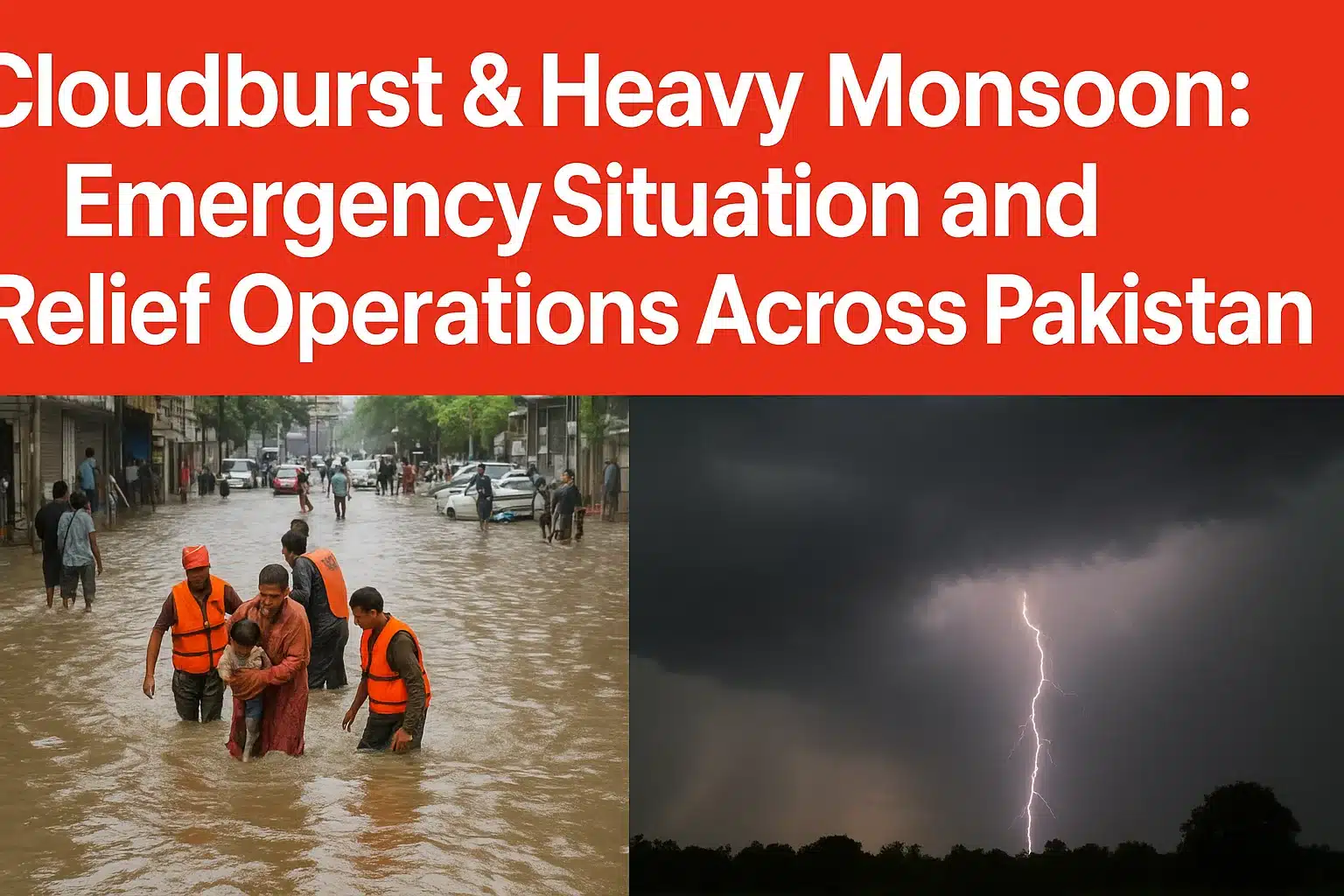Cloudburst & Heavy Monsoon in Pakistan trigger emergency alerts and relief operations. Stay updated on rainfall impact, safety measures, and rescue efforts.
On August 18, 2025, heavy monsoon rains and sudden cloudburst incidents created a state of emergency across various regions of Pakistan. According to the Pakistan Meteorological Department (PMD), the northern and central areas received exceptionally high rainfall within a short span of time, resulting in urban flooding, landslides, and overflowing rivers. The cloudburst & heavy monsoon not only submerged low-lyingt urban settlements but also disrupted transportation and communication systems. Highways, bridges, and rural link roads were severely damaged, leaving thousands of people stranded. The unusual intensity of this weather pattern has raised serious concerns about disaster preparedness and climate resilience in the country. Historical data from the PMD indicates that Pakistan has faced several extreme monsoon episodes in the past decade, but the 2025 rains are among the most intense on record, particularly in Gilgit-Baltistan, Khyber Pakhtunkhwa, and Punjab.
What is a Cloudburst and Why It is Dangerous?
A cloudburst is a rare but highly destructive weather event that occurs when extreme rainfall falls within a very limited time frame, usually less than an hour. Unlike normal rain, a cloudburst often results in flash flooding, as the ground and drainage systems cannot absorb or manage the sudden deluge of water. Meteorologists reported that in certain parts of Khyber Pakhtunkhwa (KP) and Gilgit-Baltistan, rainfall exceeded 100 mm within a single hour—a volume that typically represents an entire month’s average. This abnormal rainfall intensity triggered flash floods in mountain valleys, caused mudslides and landslides in hilly regions, submerged farmland destroying standing crops, and damaged power supply infrastructure and water channels. The destructive force of a cloudburst is magnified in steep terrain and poorly managed drainage systems, which is why northern Pakistan remains highly vulnerable during the monsoon season.
Rescue Operations and Government Response
The National Disaster Management Authority (NDMA), along with provincial disaster management units and local administrations, has launched extensive rescue and relief operations.
Emergency Evacuations
Hundreds of families from flood-prone areas in Punjab and Sindh were shifted to temporary shelters. In Khyber Pakhtunkhwa, rescue workers used boats to evacuate residents trapped in submerged villages. Military helicopters were deployed to remote valleys in Gilgit-Baltistan and Azad Jammu & Kashmir (AJK), where road access was completely cut off due to landslides.

Medical and Food Assistance
Emergency medical camps have been established in flood-affected districts. The Pakistan Army’s logistics units are distributing food packets, clean drinking water, and essential medicines. NDMA has dispatched tents, blankets, and hygiene kits to displaced families. The government has also announced financial compensation packages for those who lost their homes or crops during the disaster.
Monsoon Challenges in Urban Centers
Major urban centers including Karachi, Lahore, Islamabad, and Peshawar also experienced heavy monsoon downpours. In Karachi, several areas were submerged after just a few hours of rain, leading to traffic gridlocks and power outages. In Lahore, heavy rainfall caused waterlogging on Ferozepur Road and Canal Road, disrupting transportation and business activities. In Islamabad, drainage nullahs overflowed, flooding residential colonies near low-lying zones. Urban flooding has become a recurring challenge for major Pakistani cities during monsoon due to outdated and insufficient drainage systems, rapid urbanization without proper water management planning, and encroachments on natural waterways. City administrations have been directed to clear clogged drainage systems, but experts argue that structural reforms are needed to prevent annual monsoon damage.
Cloudburst & Heavy Monsoon in Pakistan – Instructions Issued to Citizens
Authorities have issued strict public safety guidelines during the ongoing cloudburst and heavy monsoon situation. Citizens are advised to avoid unnecessary travel, especially near rivers, canals, and nullahs; relocate immediately if living in flood-prone or low-lying areas; keep emergency kits ready including drinking water, medicines, and flashlights; report emergencies through official helplines of Rescue 1122 and NDMA; and exercise caution in using electricity and gas connections in flooded zones. The public has also been requested to cooperate with local administrations and avoid spreading unverified information that could create panic.
Expert Warnings and Weather Forecast
Weather experts have warned that the ongoing monsoon spell is likely to continue over the next five to seven days. This could intensify the risk of flooding in Punjab, Sindh, and Balochistan, while northern mountainous regions remain vulnerable to landslides. The Pakistan Meteorological Department (PMD) has issued a red alert for areas along the Indus River basin, forecasting high to very high flood levels. Similarly, catchment areas of the Jhelum and Chenab rivers are under close monitoring due to rising water inflows. According to experts, climate change is significantly contributing to the increasing unpredictability of monsoon rains in South Asia. Rising global temperatures are causing more moisture retention in the atmosphere, leading to intense rainfall events and frequent cloudbursts.
Economic and Agricultural Losses
The agricultural sector has been severely impacted by the ongoing heavy monsoon. Standing crops such as rice, maize, sugarcane, and cotton in Punjab and Sindh have been damaged by floodwaters. Farmers fear that prolonged waterlogging may further reduce yields and affect the harvest season. Economic analysts predict that damages to agriculture, infrastructure, and housing may run into billions of rupees, impacting overall economic growth. Moreover, prolonged disruption of supply chains could increase the prices of essential commodities, adding to inflationary pressures already faced by the country. The industrial sector is also facing losses due to transport delays and power outages, particularly in Karachi and Faisalabad, where factories reported temporary shutdowns.
Regional Comparisons and Historical Perspective
Pakistan is not alone in facing the devastating impact of cloudburst & heavy monsoon rains. Neighboring countries such as India, Nepal, and Bangladesh also experience seasonal monsoon-related disasters, highlighting the regional scale of vulnerability. In 2010, Pakistan experienced one of the worst floods in its history, which displaced nearly 20 million people. Experts warn that unless sustainable water management policies are implemented, similar large-scale disasters could reoccur.
The Way Forward: Building Resilience Against Monsoon Disasters
Experts emphasize that Pakistan must strengthen its disaster management strategies to minimize the impact of future cloudburst and heavy monsoon events. Suggested measures include upgrading drainage infrastructure in major urban centers to prevent recurring flooding, investing in flood forecasting technology to provide real-time early warnings, strengthening river embankments and water channels in flood-prone areas, raising community awareness about disaster preparedness and evacuation planning, and implementing climate adaptation policies to address long-term risks. International organizations such as the United Nations Development Programme (UNDP) and the Asian Development Bank (ADB) have highlighted Pakistan’s urgent need to adopt climate-resilient infrastructure and improve governance in water management.
Conclusion – Cloudburst & Heavy Monsoon in Pakistan
The ongoing cloudburst & heavy monsoon has once again highlighted Pakistan’s vulnerability to extreme weather events. With rising rainfall intensity, flash floods, and landslides, the humanitarian and economic challenges remain significant. However, with coordinated government action, timely rescue operations, and improved disaster preparedness, the country can reduce the devastating impacts of such natural calamities. As the monsoon spell continues, the focus remains on safeguarding lives, protecting infrastructure, and ensuring relief reaches vulnerable communities in time.

